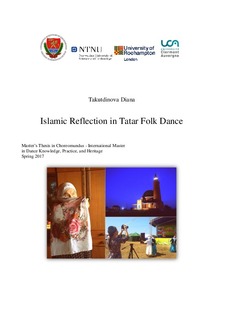| dc.description.abstract | This dissertation examines to what extent Islamic influence is preserved in Tatar folk dance. Majority of Tatars are divided into Tatars- Muslims (Sunni) and Tatars- Christians (tat: Kryashen). I have chosen dance practices of Tatar Muslims because of personal attachment to it. Tatars accepted Islam as their religion in 922. Even though entertainment activities were under the control of the religious leaders, people found time for singing and dancing. However, the representation of the dance elements and the latitude of the movements have been shaped according to the norms of Islam and further on by the respective ideologies. The aim of the dissertation is to analyze people’s awareness about Islamic reflection and norms in dance and to see what shapes ‘folk dance’ nowadays.
My field work was conducted in July-August 2016 in Tatarstan, Astrakhan, Kirov Oblast and Chuvashia. Data collection contains video recordings, photographs, participant and nonparticipant observations and interviews. During the research, following questions were raised up: Do people see any connection with Islam in Tatar folk dance? What are the main features of Tatar folk dance? Further, I formulated my questions according to the respondent’s position and relation to dance in general. Finally, the study discusses the dance elements that characterize the religious influence based on the ethnochoreological analysis. | nb_NO |
